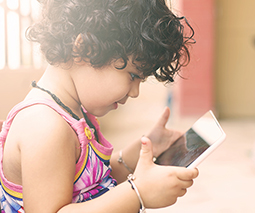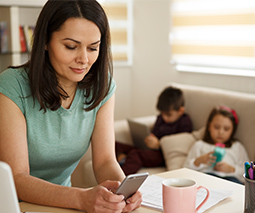Is screen time really so bad for under-twos?

Both the Australian Government and World Health Organisation, agree that children under two should have zero screen time. But Dr Kate Highfield, General Manager, Professional Learning and Research Translation at Early Childhood Australia and mother of a nearly two-year-old, simply doesn’t agree.
A different world
Overall, Kate sees the outrage over screen time as highly amusing. “A study came out about a week or so ago from the University of Queensland that said ‘shockingly’, children under two are using screens, and I just roared with laughter,” she says.
Because being the first generation to grow up completely immersed in screens, Kate believes it’s a whole new world for parents today. “Even 20 years ago, although we had televisions and phones, we didn’t have these portable devices that were as prevalent as they are today,” she says. “We’re really navigating this new territory as a generation.”
Listen to Dr Kate Highfield on Feed Play Love:
Not just a digital babysitter
“We have to acknowledge that there are times in a day when many parents do use the screen as a digital babysitter – for me, The Wiggles are on for ten minutes every morning so I can have a shower,” says Kate. “But my daughter, and in fact many other children, are using screens lots of times through the day to take photos, to look back at things, to look at digital books, to communicate.”
Kate believes that there are multiple ways to use a screen positively. “I get very nervous about the phrase ‘screen time’ because screen time could be watching something that’s truly horrible and dangerous for a child, or it could be communicating with Grandma which is wonderful and amazing,” she says. “We need to have a better conversation about what’s actually happening on the screen.”
What about harmful effects?
Kate does admit that screens can cause issues for under-twos, one being that they will displace other valuable activities. “When a mother or a father or any caregiver engages with the child and listens to the child and then engages back … we know that that interaction is absolutely essential,” says Kate. “So, the concern is that when we have screens around, it will displace those types of interactions.”
On a physical level, screens can also create postural concerns for children, particularly aged three to five. “A child who’s sitting with the iPad on their lap will probably have an over-pronated neck,” says Kate. “We should be using the tech, ironically, often lying on our tummy or sitting in various positions, not staying in the one static position for a long time.”
The effect on eyesight is another worry. “It’s that idea of having a sustained focus at one focal point,” says Kate. “It’s when we have the device set in a set position … it’s not allowing our eye muscles to develop appropriately.”

Set a good example
We all use screens in daily life, which is why Kate believes that we should be teaching our children from a very early age about how to use them properly. “Children are incredible mimics, that’s how they learn about the world,”she says. “They learn by watching us and doing what we are doing, so if we are constantly on our phones, then that’s what our children see and that’s what they think is normal.”
For this reason, Kate makes sure she turns off notifications on her phone and leaves it at the front door, along with her keys. “I’m choosing to have time to engage with the family, which I think is a fundamental thing that we all have to be practicing,” she says.
Talk about it
Talking to our children about what we’re doing on our screens is also important, whether it be sending a quick work email or writing a shopping list. “We need to be taking time to articulate what are we doing,” says Kate. “If we’re talking to our children about what we’re doing, then I think that helps them have a better understanding that it’s not just all about being distracted.”
Tech tips for parents
Tech is here to stay and Kate believes in using it well, such as communicating with grandparents. “My parents live about three hours away so often we will Facetime and share a story or share dinner or have a cup of tea together,” she says. “It creates that bond, the ability to communicate and communicate over distance.”
Kate also likes to look back at photos and past events, such as the time they took her daughter to the zoo. “She was only 15 months old and there’s no way she could have a living memory of that day but what she does have is a collection of photos of her looking at animals and a huge vocabulary around talking about those animals.”
This correlates with research on children reading books. “When we read a story and we relate it to the child’s life, that’s when language develops in a really effective way,” Kate says. “Using photos to talk about ‘remember when we went to the beach and the water was cold’, it helps build language and communication.”
Kate’s final preference is to watch something like The Wiggles, so she can have a dance with her daughter. “Jumping in and having a bop together is a really nice way to model physical activity,” she says.













